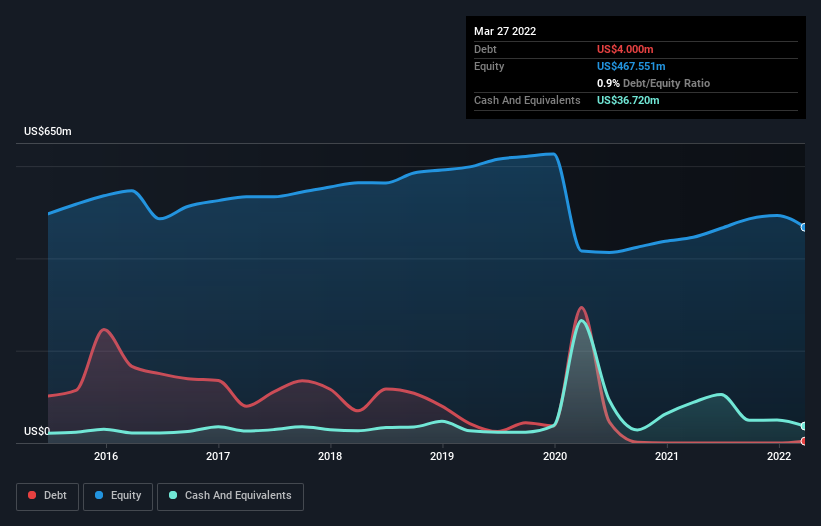These 4 Measures Indicate That TrueBlue (NYSE:TBI) Is Using Debt Safely
The external fund manager backed by Berkshire Hathaway's Charlie Munger, Li Lu, makes no bones about it when he says 'The biggest investment risk is not the volatility of prices, but whether you will suffer a permanent loss of capital.' So it might be obvious that you need to consider debt, when you think about how risky any given stock is, because too much debt can sink a company. As with many other companies TrueBlue, Inc. (NYSE:TBI) makes use of debt. But is this debt a concern to shareholders?
When Is Debt A Problem?
Debt and other liabilities become risky for a business when it cannot easily fulfill those obligations, either with free cash flow or by raising capital at an attractive price. If things get really bad, the lenders can take control of the business. However, a more frequent (but still costly) occurrence is where a company must issue shares at bargain-basement prices, permanently diluting shareholders, just to shore up its balance sheet. Having said that, the most common situation is where a company manages its debt reasonably well - and to its own advantage. The first thing to do when considering how much debt a business uses is to look at its cash and debt together.
View our latest analysis for TrueBlue
What Is TrueBlue's Net Debt?
You can click the graphic below for the historical numbers, but it shows that as of March 2022 TrueBlue had US$4.00m of debt, an increase on none, over one year. However, its balance sheet shows it holds US$36.7m in cash, so it actually has US$32.7m net cash.
How Strong Is TrueBlue's Balance Sheet?
We can see from the most recent balance sheet that TrueBlue had liabilities of US$225.9m falling due within a year, and liabilities of US$287.5m due beyond that. Offsetting these obligations, it had cash of US$36.7m as well as receivables valued at US$336.0m due within 12 months. So it has liabilities totalling US$140.7m more than its cash and near-term receivables, combined.
While this might seem like a lot, it is not so bad since TrueBlue has a market capitalization of US$557.2m, and so it could probably strengthen its balance sheet by raising capital if it needed to. But it's clear that we should definitely closely examine whether it can manage its debt without dilution. Despite its noteworthy liabilities, TrueBlue boasts net cash, so it's fair to say it does not have a heavy debt load!
Even more impressive was the fact that TrueBlue grew its EBIT by 998% over twelve months. That boost will make it even easier to pay down debt going forward. When analysing debt levels, the balance sheet is the obvious place to start. But ultimately the future profitability of the business will decide if TrueBlue can strengthen its balance sheet over time. So if you're focused on the future you can check out this free report showing analyst profit forecasts.
Finally, a business needs free cash flow to pay off debt; accounting profits just don't cut it. While TrueBlue has net cash on its balance sheet, it's still worth taking a look at its ability to convert earnings before interest and tax (EBIT) to free cash flow, to help us understand how quickly it is building (or eroding) that cash balance. Over the last three years, TrueBlue actually produced more free cash flow than EBIT. That sort of strong cash generation warms our hearts like a puppy in a bumblebee suit.
Summing up
Although TrueBlue's balance sheet isn't particularly strong, due to the total liabilities, it is clearly positive to see that it has net cash of US$32.7m. The cherry on top was that in converted 127% of that EBIT to free cash flow, bringing in -US$12m. So is TrueBlue's debt a risk? It doesn't seem so to us. When analysing debt levels, the balance sheet is the obvious place to start. But ultimately, every company can contain risks that exist outside of the balance sheet. Be aware that TrueBlue is showing 1 warning sign in our investment analysis , you should know about...
If, after all that, you're more interested in a fast growing company with a rock-solid balance sheet, then check out our list of net cash growth stocks without delay.
Have feedback on this article? Concerned about the content? Get in touch with us directly. Alternatively, email editorial-team (at) simplywallst.com.
This article by Simply Wall St is general in nature. We provide commentary based on historical data and analyst forecasts only using an unbiased methodology and our articles are not intended to be financial advice. It does not constitute a recommendation to buy or sell any stock, and does not take account of your objectives, or your financial situation. We aim to bring you long-term focused analysis driven by fundamental data. Note that our analysis may not factor in the latest price-sensitive company announcements or qualitative material. Simply Wall St has no position in any stocks mentioned.

 Yahoo Finance
Yahoo Finance 
